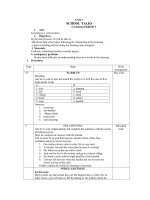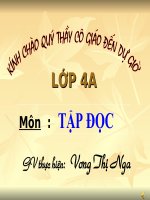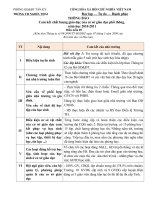BA (Hons) Primary Education: Year 1 School Based Training 2017-18
Bạn đang xem bản rút gọn của tài liệu. Xem và tải ngay bản đầy đủ của tài liệu tại đây (827.76 KB, 36 trang )
BA (Hons) Primary Education:
Year 1 School Based Training
2017-18
What difference did I
make? Why? How?
Block Placement
Briefing for Students
BA1 Unit Lead: Helen RyanAtkin
Focus of the block placement
• Teaching whole class a) from adapted teacher’s
plans, then b) your own
• Mark and assess children’s work
• Incorporate your assessment into the next
planning doc
• Act upon any feedback from CM (written or oral)
• After each RoLO, work on your targets.
• Observe CM (or other staff member) to help with
targets
• Plan for additional adults
• Plan homework and out-of-class learning
• MMU tasks and activities
Documents to send to your UVT before March 23rd
• Timetable for the first week of block
• A plan that will be used during the first week of block
• Draft action plan with targets (if decided)
• Initial contextual analysis
• First Weekly Review Meeting Record (if taken place)
16th April– 25th May
Block placement
w/c 16TH April
Agree and complete Action Plan with CM
26.3.18 – 13.4.18
MMU Easter holiday period
w/c 16th April – w/c 30th April
Interim Report window:
•UVT and CM joint observation
w/c 23rd April
Interim Report completed and grades (but not
report) sent to placements office (by 27th April)*
w/c 7th May Week 41 – look out
on your PDR Moodle page.
Students return to University for PDR tutorial
following Interim assessment week.
w/c 14th May or 21st May
Senior Moderator Visit
w/b 21st May 2018
University Tutor visit
Final Report **
25th May 2018
End of Placement
Communicating with Tutors
Pastoral
problem
Personal
Tutor
Student
experience
team lead –
Mairead
Owens
Counselling Services: 0161 247 3493
School Based
Training
Problem –
School Based
Class Mentor
and/or
Professional
Mentor
University
visiting tutor
and/or
Deputy Head
Teacher
Partnership
coordinator –
Helen RyanAtkin
Your class mentor’s role
• Agreeing timetable on a weekly basis
• Provide Schemes of Work/Medium Term Plans
• Enabling you to carry out your tasks, etc.
• Lesson Observations - 1 per week, agreed,
written feedback, focusing on the Standards
(where possible, in addition to phonics and
numeracy RoLOs)
• Progress Meeting - 1 per week, timetabled,
protected – recorded on Weekly Review and
Reflection
• Student’s files – comment on planning, teaching,
assessment, evaluations, reflections and tasks check and sign (Appx 1)
• Complete SBT Reports - Interim and Final
• Joint observation with MMU tutor - first visit
Placement Documentation
Handbooks, proformas and other key documents:
All documentation is electronic and available on the
Partnership website – see link below.
There are several areas:
•BA1 Placement – Relates specifically to this
placement
•Students: Relates to all placements
•Mentors and Tutors: Relates to all placements
Available at
www.mmu.ac.uk/education/partnerships/primary
Keep informed!
• Check SBT Moodle page regularly
• Read Helen’s emails!
• Check PDR Moodle page
• Contact UVT if any unresolvable
problems.
Handbook p8
Absences
Known absence:
•Negotiate with school, inform UVT PT and
Placements Team.
•If possible, ensure that you have left a copy
of any of your plans with your class mentor.
Unexpected absence:
•Contact the school YOURSELF by TELEPHONE
as early as possible (8.30 at the latest).
•Keep the school informed on a daily basis.
•Email the Placements Team, UVT and PT.
•Text messages to CM are NOT acceptable
Absences (cont.)
• Doctor’s note if you are absent for more
than five consecutive school days.
• All absences must be made up.
• You will need to apply for
Exceptional Factors (click to follow the link
to the guidance) if you have an absence
that will impact on your placement being
delayed in any way and at any stage, i.e. if
you are not able to complete your
placement at the scheduled time.
Your files – a reminder
• Use the Contents of School Based Training
Files . (Appendix 1 SBT Handbook).
• Files should have distinct sections that are
clearly labelled. Anyone who needs to access
your file should be able to find their way
around it.
• You are required to read and be aware of
policies indicated on the checklist. Make
notes on these.
• Students graded 1-4 on files, and can be put
at ARoF for poor files (see SBT handbook).
• PDR tutorial 4 – bring your files
Being professional – a reminder
• Time-keeping
• Dress
• Attitude
• Social media
• Mobile phones
• Understanding the demands on staff
time
The Block Placement
Teaching requirements = Progressive
•Week 1: 20% (one day equivalent). Observe P.E.
•Week 2: 30% (1.5 days equivalent). Teach Phonics
•Week 3: 40% (2 days)
Teach Phonics
•Weeks 4-6: 50% (2.5 days) Teach P.E.
•Whole class teaching and group work appropriate to
the setting (core and foundation subjects)
Other requirements
10% = file time
40% = professional development
PPA time to negotiated around these
Paired Placement Guidance
Students will be engaging in one of four ways at any one time:
•Team teaching
•Lead teacher
•Group teacher
•Peer observation
See Paired and Pod Placement Guidance Handbook
Paired Placement Peer Observation
Date of observation:
Lesson/session:
p12 in Paired
Placement HB
Observed colleague:
Observed colleague:
summary of main outcomes
(e.g. what you got out of the
observation, feedback &
discussion)
Observer:
Observer: summary comments
(e.g. what impressed you about the
session/things you may adapt in
your own teaching)
Agreed action points and any other matters arising:
Paired Placements: An example of a 50% teaching
timetable for Student A & Student B
Session 1
Monday
Tuesday
Wednesday
Thursday
Friday
Student A
Student A
Student A
Team
Lead Teacher Lead Teacher Lead Teacher Teaching
Student B –
Group
Teacher
2
Team
teaching
Student B –
Group
Teacher
Student B –
Group
Teacher
Student B
Student B
Student B
Lead Teacher Lead Teacher Lead Teacher
A – Group
Teacher
A – Group
Teacher
A – Group
Teacher
3
Student B
Student A
Lead Teacher Lead Teacher
4
Student B
Student A
Lead Teacher Lead Teacher
EYFS: Example of how the teaching timetable might
look: 50% at Final
Session 1
Monday
Tuesday
Student A
Lead Teacher
Student B –
Group
Teacher
Wednesday
Student A
Lead Teacher
Student B –
Group
Teacher
Thursday
Student A
Lead Teacher
Student B –
Group
Teacher
Friday
Team
Teaching
2
Team
teaching
Student B
Lead Teacher
Student A –
Group
Teacher
Student B
Lead Teacher
Student A –
Group
Teacher
Student B
Lead Teacher
Student A –
Group
Teacher
3
Student B
Lead Teacher
Student A
Lead Teacher
Student B
Lead Teacher
Student A
Lead Teacher
4
If students are paired in EYFS setting then as the Lead Teacher, the
student can plan for the continuous provision and other focus group
activities. Student B can plan and deliver a focus group activity during
this time
Trio-placements: an example
Mon
Tues
Wed
Thurs
Fri
ABC
AC
C
AB
CB
AC
BC
AB
AC
BCA
BAC
BC
AB
AC
B
• Take turns in being Lead Teacher, Support
Teacher and Observer.
• Opportunities for Team Teaching
How you will be assessed
• Your own lesson
evaluations
• Teachers Standards/
Primary Grading Criteria
• Weekly RoLOs
• SBT Interim and Final
Reports
• Informal feedback
• Specific Phonics and Early
Maths RoLOs
Alternative RoLO for Paired Placements
Secure subject
knowledge is evident.
Student has secure
understanding.
S3
Selects appropriate
pedagogy for
teaching.
S2
Children are engaged
Student displays good model of
in learning and display standard English both written
enthusiasm.
and spoken.
S1
S3
Identifies learning
intentions in planning.
Challenges all children.
S1 S4
Takes into account
children’s prior
knowledge +
understanding.
S4
Plans are clearly
differentiated.
Plans opportunities for
children to take
responsibility for their
own learning. S2
Is independent in planning and
contributes own ideas.
Develops and makes own
resources.
S4
Annotates planning on a
regular basis.
S6
Will readily change
and adapt planning if
required.
S6
Plans display a clear
learning objective.
S4
Opportunities for assessment are
included in planning.
S6
Student is aware of
their impact on
children’s learning.
Pace of the lesson is
appropriate.
S2
S4
Session time is
maximised.
Teaching is creative and engaging.
Learning objective is
shared with the children.
Learning objective maybe
displayed.
S4
Range of teaching
approaches are used.
S2 S4
Obvious differentiation
in teaching.
S4
Student is aware of
any barriers to
children’s learning. S5
Teaching meets the
needs of all children.
S5
Takes into account children’s
individual targets.
Effective use of
questioning.
Allows children to think
independently and
problem solve.
S1 S2
Refers back to the
learning objective
throughout lesson.
Explanations and
instructions are clear
and easy for children
to follow.
S7
Opportunities for collaborative
learning are evident. I.e. talking
partners.
S2 S4
AFL opportunities evident
and used to assess
children’s learning.
S2
Allows children to
reflect on their own
learning.
Monitors progress
Uses written and oral
being made and is able feedback to monitor
to reflect on this.
pupils’ progress.
S6
S6
Uses school’s marking policy.
Gains respect of children.
Displays positive and
purposeful atmosphere.
S7
Has established clear
rules and routines for
behaviour. Sets high
expectations.
S7
Uses a range of
behaviour strategies.
S7
Can motivate and enthuse the
children and has strong, positive
relationships.
S7
Subject knowledge
Planning
Teaching
Assessment
Classroom and
behaviour management
Addresses
misconceptions or
understanding of
children’s learning.
S3
S4
S2
S5
S4
S4
S4
S4
Effectively manages
children’s behaviour.
S7
S5
S6
Weekly Review Meetings
• A dedicated meeting time
• You are responsible for completing the
document
• An opportunity to be reflective and reflexive
• Prepare as much as possible beforehand
• A chance to discuss your progress
• Review your lesson evaluations
• Review the last RoLO and your targets
• Discuss following week’s plans and actions
• Update on task completion
‘Focus Time’
• Students to spend 3-5 days in EYFS if base class is
KS1/KS2, and vice versa in a specified alternative class.
• Students get to know the routines, rules, staff and
children.
• Arrangements for students in stand-alone nurseries
• Task 1: observe children and adults and make notes on
similarities and differences in how teaching and
learning is organised with base class.
• Task 2: plan, teach and assess the learning of a group
of children in the alternative class.
• Task 3: Evaluate the above session and suggest next
steps for you and the children. Discuss with CT.
•
Typical Professional Development Time Activities
• Work on targets from RoLOs
• Observe other teachers around the school
• Talk to/shadow the SENCO
• Discussion with subject leaders
• Becoming familiar with assessment systems
• Sit in with any other outside professionals
who are working with children in your class
• Early reading, maths and science tasks
• Bilingualism Portfolio
• Preparing materials and displays
The Bilingual Learners Portfolio
• Students complete this over the 3
years.
• Some tasks are about working with
EAL children
• If no EAL children in your class,
arrange for student to go
elsewhere.
• There are tasks to complete which
are more research-based.
Reading, Mathematics and Science Tasks
• Early Reading and Phonics – p 21
Task 1: short report
Task 2: journal and short report
Task 3: Phonics RoLO and evaluation
• Early Mathematics – booklet
• Science Task – on Moodle









